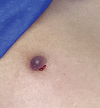Thoracic sympathectomy for hyperhidrosis: from surgical indications to clinical results
- PMID: 28446983
- PMCID: PMC5392541
- DOI: 10.21037/jtd.2017.04.04
Thoracic sympathectomy for hyperhidrosis: from surgical indications to clinical results
Abstract
Sympathectomy and its variations have been performed in thoracic surgery for more than 100 years. However, its indications have undergone profound modifications in this period. Likewise, since then the surgical technique has also evolved dramatically up to the minimally invasive techniques worldwide accessible in present days. Currently, primary hyperhidrosis is, by far, the main indication for thoracic sympathectomy and this procedure is usually carried out thoracoscopically with excellent results. However, until today, hyperhidrosis is a part of thoracic surgery still surrounded by controversy, persisting as an open field over which some confusion still resides regarding its pathophysiology, terms definitions and operative approaches. The aim of this article is to provide a wide but easily comprehensible review of the theme, discussing and clarifying the major concepts with respect to its clinical presentation, all the presently available treatment options and strategies with their potential benefits and risks, the adequate patient selection for sympathectomy, as well as the postoperative clinical results.
Keywords: Sympathectomy; hyperhidrosis; sweating; sympathetic nervous system; video-assisted thoracic surgery.
Conflict of interest statement
Conflicts of Interest: The authors have no conflicts of interest to declare.
Figures










Similar articles
-
One-year follow-up period after transumbilical thoracic sympathectomy for hyperhidrosis: outcomes and consequences.J Thorac Cardiovasc Surg. 2014 Jan;147(1):25-8. doi: 10.1016/j.jtcvs.2013.08.062. Epub 2013 Oct 28. J Thorac Cardiovasc Surg. 2014. PMID: 24176274
-
Thoracoscopic sympathicotomy in the treatment of palmar hyperhidrosis.Asian Cardiovasc Thorac Ann. 2016 Sep;24(7):687-91. doi: 10.1177/0218492316657729. Epub 2016 Jun 28. Asian Cardiovasc Thorac Ann. 2016. PMID: 27357114
-
Needlescopic Video-Assisted Thoracic Bilateral T4 Sympathicotomy for the Treatment of Primary Palmar Hyperhidrosis: An Analysis of 200 Cases.Thorac Cardiovasc Surg. 2019 Aug;67(5):395-401. doi: 10.1055/s-0038-1645872. Epub 2018 May 1. Thorac Cardiovasc Surg. 2019. PMID: 29715706
-
Video-Assisted Thoracic Sympathectomy for Hyperhidrosis.Thorac Surg Clin. 2016 Aug;26(3):347-58. doi: 10.1016/j.thorsurg.2016.04.010. Thorac Surg Clin. 2016. PMID: 27427529 Review.
-
Thoracic sympathectomy: a review of current indications.Surg Endosc. 2016 Apr;30(4):1255-69. doi: 10.1007/s00464-015-4353-0. Epub 2015 Jun 27. Surg Endosc. 2016. PMID: 26123342 Review.
Cited by
-
Longitudinal Assessment of Facial Hyperhidrosis Management: Evaluating the Utility and Quality of Life Improvements following Botulinum Toxin Injection.Toxins (Basel). 2024 Jan 21;16(1):59. doi: 10.3390/toxins16010059. Toxins (Basel). 2024. PMID: 38276535 Free PMC article.
-
Robotic Sympathectomy for Hyperhidrosis.Cureus. 2023 Jan 17;15(1):e33885. doi: 10.7759/cureus.33885. eCollection 2023 Jan. Cureus. 2023. PMID: 36660238 Free PMC article. Review.
-
Predictors of Compensatory Sweating and Satisfaction Following Endoscopic Thoracic Sympathetic Chain Clipping for Palmar/Axillary Hyperhidrosis.J Clin Med. 2025 Jan 8;14(2):326. doi: 10.3390/jcm14020326. J Clin Med. 2025. PMID: 39860332 Free PMC article.
-
Persistent Horner Syndrome Following Bilateral Endoscopic Thoracic Sympathotomy: A Case Report.Neuroophthalmology. 2024 Mar 12;48(5):364-368. doi: 10.1080/01658107.2024.2324397. eCollection 2024. Neuroophthalmology. 2024. PMID: 39145325 Free PMC article.
-
Primary hyperhidrosis: an updated review.Drugs Context. 2025 Jun 16;14:2025-3-2. doi: 10.7573/dic.2025-3-2. eCollection 2025. Drugs Context. 2025. PMID: 40575073 Free PMC article. Review.
References
-
- 1. Alexander W. The treatment of epilepsy. Edinburgh: Young J Pentland, 1889: 27-106.
-
- Kotzareff A. Resection partielle du tronc sympathique cervical droit pour hyperhidrose unilaterale. Rev Med Suisse Rom 1920;40:111-3.
Publication types
LinkOut - more resources
Full Text Sources
Other Literature Sources
